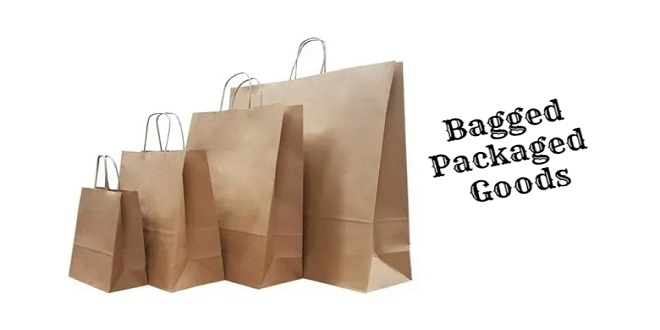Packaged Goods in : Their Types and Benefits

American consumers are more inclined to accept bagged packaged goods.
Bags are able to hold nearly any type of food product. The bag can be used as a container for food products.
Bags are also recyclable and compostable, making them more environmentally-friendly.
You need to be aware of some things when purchasing bagged packaged goods. Read the ingredient list.
Bagged packaged goods can be a great way to save time and money at the grocery store. Before you buy, make sure to inspect the packaging for any damage and check the expiration date.
Americans value convenience. We love food that is quick and convenient. There are many options for bagged packaged goods, such as chips, cookies and salads.
The market for bagged packaged foods continues to grow. Packaged Facts, a market research firm, reported that 2017 US sales of packaged food totalled $795 billion. This represents a $767 billion increase over 2016 and is expected to rise to $854 million in 2022, according to Packaged Facts.
What is driving this growth? Many factors contribute to this growth.
Types and sizes of bagged packaged goods
Different brands require different packaging materials. These are the most popular materials:
Aseptic Processing
Bags
Boxes
Cans
Cartons
Flexible packaging
Pallets
Trays
Wrappers
ASEPTIC PROCESSING
Aseptic processing refers to the process of preventing the growth and spread microorganisms from food.
Milk
Drinkable products containing milk
Liquid eggs
Long preservation times are required for processed foods
BAGS
American shoppers went grocery shopping almost 300 times per month. The average American consumer went grocery shopping nearly 300 times per month.
Bagged packaged goods are popular for many reasons. Many bags come with simple labels that clearly show what’s inside.
Shopping for groceries online has its disadvantages. Bagged goods are more expensive than those that are not packaged.
Bags are suitable for carrying food, such as:
Pretzels and chips are great snacks.
Vegetables and fruits
BOXES
The average American consumes 60-six pounds of packaged, boxed and bagged goods each year. Everything, from cereal to laundry soap, comes in bags, boxes or packages.
Packaging is more than just a protective device for food products. Packaging is not only used to protect food products, but also serves as a marketing tool.
All the packaging is harmful to the environment. There is also the issue of the waste stream. Most packaging can be recycled or composted. Many of the packaging cannot be recycled.
These are often used in foods like:
Cereal
Frozen pizza
Snack crackers
CANS
MarketsandMarkets estimates that the global metal packaging market will grow by 4.8% between 2016-2021.
Bagged packaged foods make it simple to purchase food.
Cans mainly used for food and beverage packaging. These cans can be used to transport household goods from one place to another.
Canning can be used to make many foods, such as
Vegetables
Grab a glass of water
Fruit
Soup
Meats
Gravy
CARTONS
Carton-based packaging has been around for a while. It is not a new concept.
Carton has the ability to protect goods during shipping. This is one of their biggest advantages. Carton is great for shipping fragile items. This is great for packaging food or other items that are prone to moisture and exposure.
More people are using cartons to bag packaged goods. Carton can be recycled multiple times.
There is a variety of food packaging styles, including
Egg cartons
Aseptic cartons
Folding cartons
Gable-top cartons
Flexible Packaging
Flexible packaging has become a rage in packaging. Brands can now find new ways to attract customers and make their products stand out from the crowd.
Flexible packaging is lighter than rigid packaging. This is one advantage of flexible packaging. It is lighter than rigid packaging and can be shipped or stored in smaller quantities. This can reduce overall costs and can also result in shorter production times.
Flexible packaging can also made from recycled materials.
PALLETS
A company’s inability to purchase pallets could result in a loss of money. Pallets allow for easier transportation of goods and improve efficiency.
TRAYS
Tray packaging plays a significant role in our economy. Tray packaging is great for products that need to be transported or stored in harsh environments.
They preserve food’s quality. Employees can quickly stock shelves using trays.
Groceries often stock plastic trays. These trays can be washed easily and can be reused many times.
These food products are a benefit:
Drinks
Meat
Plant seeds
WRAPPERS
Plastic wrap is often used to protect items from getting wet and dirty.
Saran wrap, and other wrappers, can leach chemicals into foods.
These can be used to create certain items, such
Candy
Granola bars
You have three choices when grocery shopping. You can either go to the store and pick the items or order online to have it delivered to you. You can order online and get most things you need quickly.
There are many things to consider when shopping for bagged packaged goods. What size do you need? Then, what packaging are you looking for? Are they resealable? What quality do they need?
There are many things to consider when shopping for bagged packaged goods. What size do you need?
The United States consumes more than 10,000,000 bags annually to package groceries. While plastic bags are becoming more expensive at grocery stores, paper bags remain popular.
Each year, the average American throws out 65 pounds of packaging waste. This amounts to $11.8 billion annually.
While paper and other biodegradable materials are more environmentally friendly, they are more expensive and take up more space in the landfill. Plastic bags, on the other hand are lighter and can take hundreds to decompose.
Food Packaging Plastic Bags
Food packaging is the most common type. Some plastic bags can be used only once while others can be used multiple times.
You need to consider your needs before you make a decision about the type of bag you will use. If you want a bag that can withstand heat or moisture, a polypropylene bag will be the right choice.
A bag is available for all types of food packaging.
There are 3 types of plastic bags you can use for food packaging:
1. High Density Polyethylene, (HDPE),
HDPE plastic is used in packaging. HDPE can also recycled many times.
2. Low Density Polyethylene, (LDPE),
Packaging can have a significant impact on the shelf life of many products.
3. Linear low density polyethylene (LLDPE).
Packaged goods that are bagged are an essential part of daily life. Be familiar with the different materials used in bagging so you can choose the best one for your needs.
LLDPE or linear low density polyethylene, is a common material used for bagging.
4. Polypropylene, (PP)
Packaged goods in bags have many benefits
It’s easy to transport
If you are always on the go, bagged packed goods are essential. Keep your food fresh with bags with built-in closures.
Reusable
We must be mindful of our environment. Reuseable bags are a better option than disposable bags.
Bags for packaged goods can be found in many sizes and shapes. Some are biodegradable.
Reusable bag can help reduce the amount of waste you produce each week. Reusable bag are usually cheaper than disposable bags and last longer.
Food safety
Food bags provide additional protection. Food bags trap air around food to keep it fresh.




